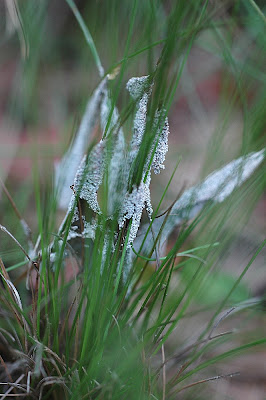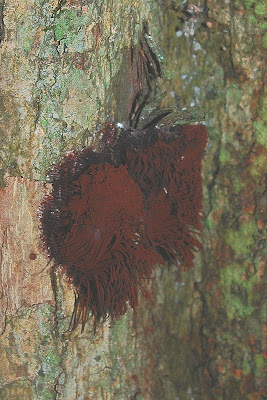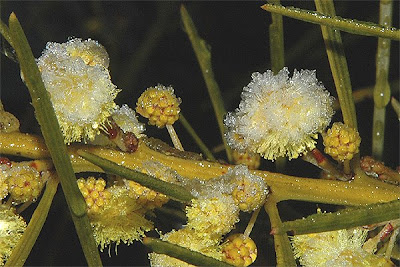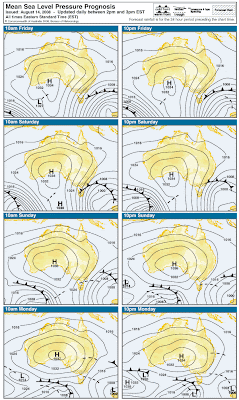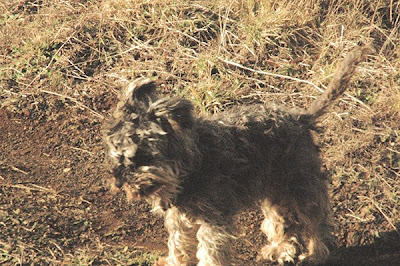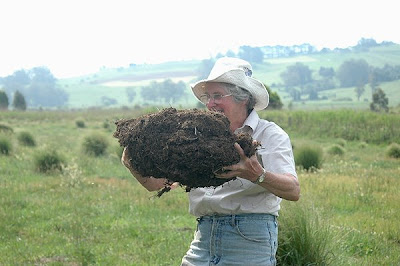 This huge ugly scar is the Limestone Quarry at Bungonia. This view is seen from Badgery's Lookout, which is actually further away from the quarry than Longpoint Lookout. The machinery and sheds are clearly visible on the right hand side.
This huge ugly scar is the Limestone Quarry at Bungonia. This view is seen from Badgery's Lookout, which is actually further away from the quarry than Longpoint Lookout. The machinery and sheds are clearly visible on the right hand side. This is what the Bungonia Quarry looks like from the air.
This is what the Bungonia Quarry looks like from the air. This is the sight you see from Longpoint Lookout. The Shoalhaven River flows through two huge horseshoe bends, as it flows from the right (west) to left. It is just about to enter the classic Shoalhaven Sandstone country - with near vertical clifflines, such as one sees at Fitzroy Falls. You can see the beginning of such formations on the left of the photo - whereas, in the centre, the hills are steelpy sloping, but not with cliffs - indicating their different metamorphic geology to which I referred. The Limestone geology upon which the Bungonia caves are founded is actually just a couple of kilometres away, but it was out of sight from this point. I could hear the huge machines operating, while at this lookout. It is that close. So, again, that confirms the complex mixture of geological formations in this small area. I had written a reference to the "mighty" Shoalhaven River, but there is very little of it, in truth. But by Australian standards, it is a mighty river valley.
This is the sight you see from Longpoint Lookout. The Shoalhaven River flows through two huge horseshoe bends, as it flows from the right (west) to left. It is just about to enter the classic Shoalhaven Sandstone country - with near vertical clifflines, such as one sees at Fitzroy Falls. You can see the beginning of such formations on the left of the photo - whereas, in the centre, the hills are steelpy sloping, but not with cliffs - indicating their different metamorphic geology to which I referred. The Limestone geology upon which the Bungonia caves are founded is actually just a couple of kilometres away, but it was out of sight from this point. I could hear the huge machines operating, while at this lookout. It is that close. So, again, that confirms the complex mixture of geological formations in this small area. I had written a reference to the "mighty" Shoalhaven River, but there is very little of it, in truth. But by Australian standards, it is a mighty river valley. You will realise that I did not come down to this wild and inaccessible spot, just for the view. I was checking out this area for Orchids, of course. I only found Nodding Greenhoods (Pterostylis nutans) in flower, unfortunately.
You will realise that I did not come down to this wild and inaccessible spot, just for the view. I was checking out this area for Orchids, of course. I only found Nodding Greenhoods (Pterostylis nutans) in flower, unfortunately.There were a few plants, some with advanced buds. This plant sometimes forms great colonies, but, alas, not here. It is probably not wet enough for that to happen. This section of the Shoalhaven Valley is in a low rainfall area, and the geology is very rocky and the slopes are very steep - so any rain which does fall runs off almost straight away.
 There were some fully mature flowers, such as this one, with the pollinia clearly visible inside the "hood" (galea) of the flower.
There were some fully mature flowers, such as this one, with the pollinia clearly visible inside the "hood" (galea) of the flower. Another Orchid growing here, but not in flower, is the Dockrillia striolatum (a.k.a. Dendrobium striolatum). In this region, this plant grows predominantly on rocks. The case here, where the roots are within a narrow crack in the rock is a typical manner of growth of this plant - on a vertical rock face. This plant has triangular shaped leaves (in cross section) strangely reminiscent of a "Pigface". The leaves are thickly coated in order to reduce transpiration and to maximise water conservation - which when growing on a vertical rock face, has to be a priority.
Another Orchid growing here, but not in flower, is the Dockrillia striolatum (a.k.a. Dendrobium striolatum). In this region, this plant grows predominantly on rocks. The case here, where the roots are within a narrow crack in the rock is a typical manner of growth of this plant - on a vertical rock face. This plant has triangular shaped leaves (in cross section) strangely reminiscent of a "Pigface". The leaves are thickly coated in order to reduce transpiration and to maximise water conservation - which when growing on a vertical rock face, has to be a priority.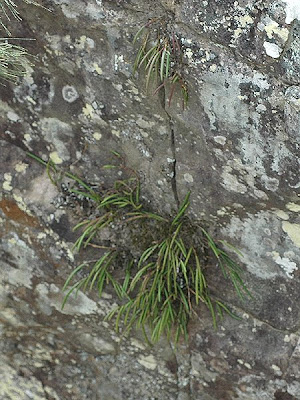 Here is a photo of a female Grey Kangaroo, with a small joey poking its head out from her pouch, and a youngster (presumably from last year) still at heel with her. These Kangaroos were living on the relatively poor farm lands several kilomentres from the Longpoint Lookout.
Here is a photo of a female Grey Kangaroo, with a small joey poking its head out from her pouch, and a youngster (presumably from last year) still at heel with her. These Kangaroos were living on the relatively poor farm lands several kilomentres from the Longpoint Lookout.








